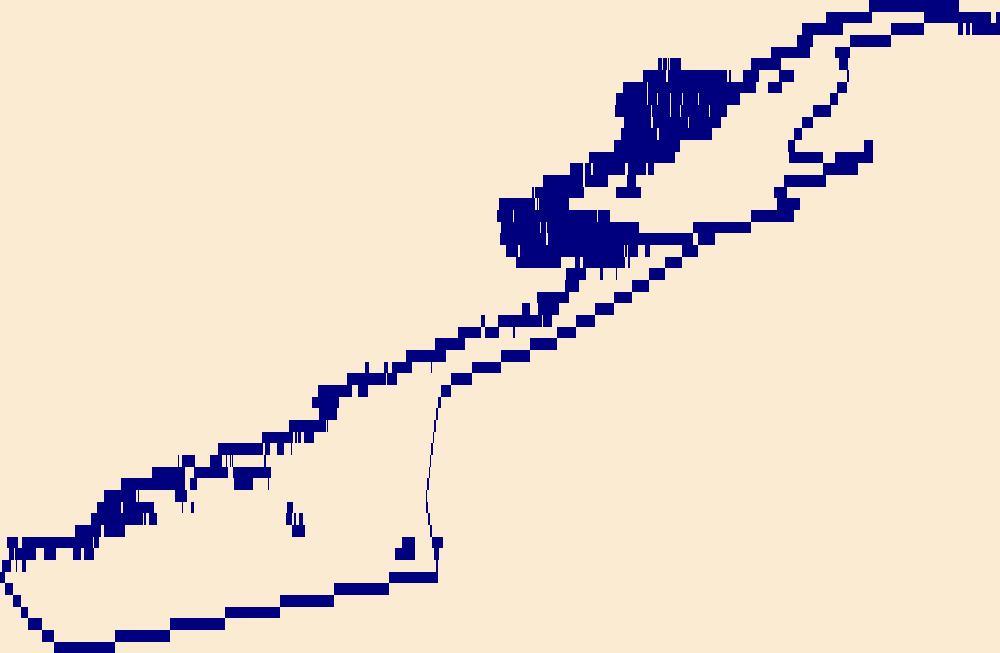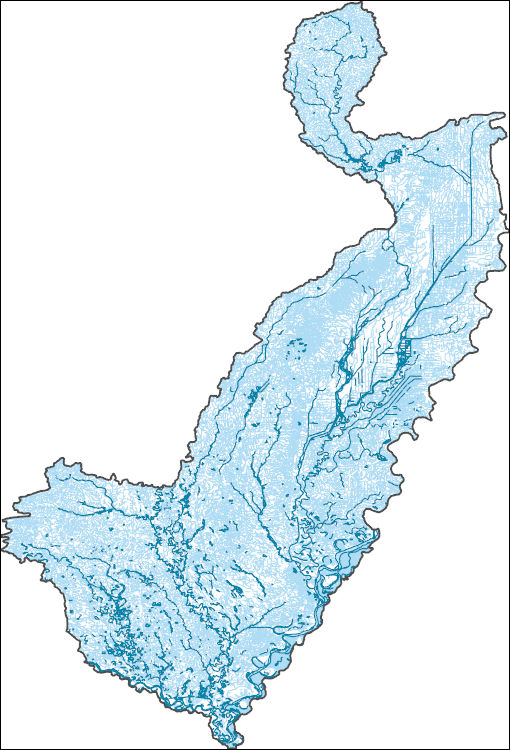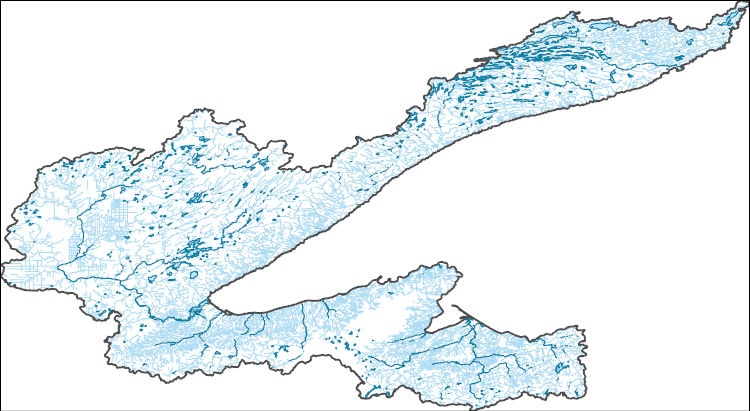Filters: Tags: Inland Waters (X)
602 results (74ms)|
Filters
Date Range
Extensions Types Contacts
Categories Tag Types
|

These data were released prior to the October 1, 2016 effective date for the USGS’s policy dictating the review, approval, and release of scientific data as referenced in USGS Survey Manual Chapter 502.8 Fundamental Science Practices: Review and Approval of Scientific Data for Release. In 2009, the Kootenai Tribe of Idaho released and implemented the Kootenai River Habitat Restoration Master Plan. This plan aimed to restore, enhance, and maintain the Kootenai River habitat and landscape to support and sustain habitat conditions for aquatic species and animal populations. In support of these restoration efforts, the U.S. Geological Survey, in cooperation with the Kootenai Tribe of Idaho, conducted high-resolution...

These data were released prior to the October 1, 2016 effective date for the USGS’s policy dictating the review, approval, and release of scientific data as referenced in USGS Survey Manual Chapter 502.8 Fundamental Science Practices: Review and Approval of Scientific Data for Release. Water levels in 93 wells completed in the Wood River Valley aquifer system were measured during October 22–24, 2012; these wells are part of a network established by the U.S. Geological Survey in 2006. Maps of the October 2012 water-table altitude in the unconfined aquifer and the potentiometric -surface altitude of the confined aquifer have similar topology to those on maps of October 2006 conditions. Between October 2006 and October...

These data were released prior to the October 1, 2016 effective date for the USGS’s policy dictating the review, approval, and release of scientific data as referenced in USGS Survey Manual Chapter 502.8 Fundamental Science Practices: Review and Approval of Scientific Data for Release. According to the U.S. Geological Survey, an estimated 258 million people nationwide, or 86% of the U.S. population, relied on public water supplies for their household use in 2005 (USGS, 2013). The remaining population obtains their water from different sources, such as a domestic self-supply well. However, the spatial distribution of water supply systems has not been compiled. Mapping where these people are located can be done within...

These data were released prior to the October 1, 2016 effective date for the USGS’s policy dictating the review, approval, and release of scientific data as referenced in USGS Survey Manual Chapter 502.8 Fundamental Science Practices: Review and Approval of Scientific Data for Release. The hydrogeologic framework was developed from a combination of the physiography and the predominant texture of surficial geologic units in the Mid-Atlantic Coastal Plain. It describes the primary natural physical factors that affect the flow and chemistry of shallow ground water and small streams in the Mid-Atlantic Coastal Plain. Seven hydrogeologic subregions were defined. Some of the subregions correspond directly to the physiographic...

These data were released prior to the October 1, 2016 effective date for the USGS’s policy dictating the review, approval, and release of scientific data as referenced in USGS Survey Manual Chapter 502.8 Fundamental Science Practices: Review and Approval of Scientific Data for Release. This data set represents the extent of the Basin and Range aquifers in the states of California, Utah, Arizona, and Nevada.

These data were released prior to the October 1, 2016 effective date for the USGS’s policy dictating the review, approval, and release of scientific data as referenced in USGS Survey Manual Chapter 502.8 Fundamental Science Practices: Review and Approval of Scientific Data for Release. The surficial bed-sediment facies, herein after referred to as the sediment facies, quantitatively describes the dominant sediment substrate on the surface of the river bed. Sediment facies categories were based on the grain size distribution of Wentworth (1922) which included the following ranges or combination of ranges: gravel (2-64mm), sand (0.063-2mm) and silt/clay (less than 0.063mm). An underwater video monitoring system UVMS...

These data were released prior to the October 1, 2016 effective date for the USGS’s policy dictating the review, approval, and release of scientific data as referenced in USGS Survey Manual Chapter 502.8 Fundamental Science Practices: Review and Approval of Scientific Data for Release. The substrate enhancement pilot project (SEPP) extent GIS layer represents an area where an artificial substrate will be placed. The artificial substrate, consisting of a mixed size class of gravel, is aimed at providing a more suitable substrate for sturgeon eggs and early-life rearing habitat. The location of the SEPP extent was created by analyzing the egg-mat network, bathymetric features, surficial sediment facies, and streamflow...
Suspended-sediment concentrations are reported in mg/L for water samples collected from the San Lorenzo River during the rainy seasons from 2008 to 2019. Samples were collected during 2-, 5- and 10-year flood events.

The High Resolution National Hydrography Dataset Plus (NHDPlus HR) is an integrated set of geospatial data layers, including the best available National Hydrography Dataset (NHD), the 10-meter 3D Elevation Program Digital Elevation Model (3DEP DEM), and the National Watershed Boundary Dataset (WBD). The NHDPlus HR combines the NHD, 3DEP DEMs, and WBD to create a stream network with linear referencing, feature naming, "value added attributes" (VAAs), elevation-derived catchments, and other features for hydrologic data analysis. The stream network with linear referencing is a system of data relationships applied to hydrographic systems so that one stream reach "flows" into another and "events" can be tied to and traced...

The High Resolution National Hydrography Dataset Plus (NHDPlus HR) is an integrated set of geospatial data layers, including the best available National Hydrography Dataset (NHD), the 10-meter 3D Elevation Program Digital Elevation Model (3DEP DEM), and the National Watershed Boundary Dataset (WBD). The NHDPlus HR combines the NHD, 3DEP DEMs, and WBD to create a stream network with linear referencing, feature naming, "value added attributes" (VAAs), elevation-derived catchments, and other features for hydrologic data analysis. The stream network with linear referencing is a system of data relationships applied to hydrographic systems so that one stream reach "flows" into another and "events" can be tied to and traced...

The High Resolution National Hydrography Dataset Plus (NHDPlus HR) is an integrated set of geospatial data layers, including the best available National Hydrography Dataset (NHD), the 10-meter 3D Elevation Program Digital Elevation Model (3DEP DEM), and the National Watershed Boundary Dataset (WBD). The NHDPlus HR combines the NHD, 3DEP DEMs, and WBD to create a stream network with linear referencing, feature naming, "value added attributes" (VAAs), elevation-derived catchments, and other features for hydrologic data analysis. The stream network with linear referencing is a system of data relationships applied to hydrographic systems so that one stream reach "flows" into another and "events" can be tied to and traced...

A warming climate could profoundly affect the distribution and abundance of many fishes. Bull trout (Salvelinus confluentus) may be especially vulnerable to climate change given that spawning and early rearing are constrained by cold water temperatures creating a patchwork of natal headwater habitats across river networks. Because the size and connectivity of patches also appear to influence the persistence of local populations, climate warming could lead to increasing fragmentation of remaining habitats and accelerated decline of this species. We modeled the relationships between (1) the lower elevation limits of small bull trout and mean annual air temperature and (2) latitude and longitude across the species'...

A warming climate could profoundly affect the distribution and abundance of many fishes. Bull trout (Salvelinus confluentus) may be especially vulnerable to climate change given that spawning and early rearing are constrained by cold water temperatures creating a patchwork of natal headwater habitats across river networks. Because the size and connectivity of patches also appear to influence the persistence of local populations, climate warming could lead to increasing fragmentation of remaining habitats and accelerated decline of this species. We modeled the relationships between (1) the lower elevation limits of small bull trout and mean annual air temperature and (2) latitude and longitude across the species...

A warming climate could profoundly affect the distribution and abundance of many fishes. Bull trout (Salvelinus confluentus) may be especially vulnerable to climate change given that spawning and early rearing are constrained by cold water temperatures creating a patchwork of natal headwater habitats across river networks. Because the size and connectivity of patches also appear to influence the persistence of local populations, climate warming could lead to increasing fragmentation of remaining habitats and accelerated decline of this species. We modeled the relationships between (1) the lower elevation limits of small bull trout and mean annual air temperature and (2) latitude and longitude across the species...
Inland water ecosystems dynamically process, transport, and sequester carbon. However, the transport of carbon through aquatic environments has not been quantitatively integrated in the context of terrestrial ecosystems. Here, we present the first integrated assessment, to our knowledge, of freshwater carbon fluxes for the conterminous United States, where 106 (range: 71–149) teragrams of carbon per year (TgC⋅y−1) is exported downstream or emitted to the atmosphere and sedimentation stores 21 (range: 9–65) TgC⋅y−1 in lakes and reservoirs. We show that there is significant regional variation in aquatic carbon flux, but verify that emission across stream and river surfaces represents the dominant flux at 69 (range:...
Categories: Publication;
Types: Journal Citation;
Tags: Aquatic carbon,
Carbon flux,
Conterminous United States,
Inland waters,
Terrestrial carbon
These data were compiled to accompany flow modeling work on Kanab Creek near the mouth (USGS gage 09403850). The data include topographic data collected by a remote sensing detection light detection and ranging (LIDAR) system and surveying total station in June 2017, high water marks from six floods from 2011 to 2013, and control points and gage structures. Topographic data include ground topography collected by LIDAR and channel bathymetry collected by total station survey of a 600 meter reach of Kanab Creek, ending at the confluence with the Colorado River in Grand Canyon, Arizona. High water mark data include sets from six floods collected by USGS personnel using total station surveys.
Water-surface elevation measurements were collected in March 2015 along the upper Willamette River, Oregon, between Eugene to Corvallis. These surveys were collected over a small range of discharges using a real time kinematic global positioning system (RTK-GPS) on a motorboat traveling "on plane" along the river. These datasets were collected for equipment calibration and validation for the National Aeronautics and Space Administration’s (NASA) Surface Water and Ocean Topography (SWOT) satellite mission. This is one of multiple survey datasets that will be released for this effort.
Categories: Data;
Types: Citation,
Downloadable,
Map Service,
OGC WFS Layer,
OGC WMS Layer,
Shapefile;
Tags: AirSWOT,
Corvallis,
Eugene,
Oregon,
RTK,
These data are high-resolution bathymetry (riverbed elevation) and depth-averaged velocities in ASCII format, generated from hydrographic and velocimetric surveys of the Missouri River near dual bridges structure A4557 on Missouri State Highway 370 near St. Louis, Missouri, in 2010, 2011, and 2016. Hydrographic data were collected using a high-resolution multibeam echosounder mapping system (MBMS), which consists of a multibeam echosounder (MBES) and an inertial navigation system (INS) mounted on a marine survey vessel. Data were collected as the vessel traversed the river along planned survey lines distributed throughout the reach. Data collection software integrated and stored the depth data from the MBES and...
These data are high-resolution bathymetry (riverbed elevation) and depth-averaged velocities in ASCII format, generated from hydrographic and velocimetric surveys of the Mississippi River near structures A4936/A1850 on Interstate 255 near St. Louis, Missouri, in 2008, 2009, 2010 and 2016. Hydrographic data were collected using a high-resolution multibeam echosounder mapping system (MBMS), which consists of a multibeam echosounder (MBES) and an inertial navigation system (INS) mounted on a marine survey vessel. Data were collected as the vessel traversed the river along planned survey lines distributed throughout the reach. Data collection software integrated and stored the depth data from the MBES and the horizontal...
These data are currently under revision and will be available again in a few weeks. Please check back in April 2019 or contact Richard J Huizinga for more information. These data are high-resolution bathymetry (riverbed elevation) in ASCII format, generated from hydrographic surveys near six highway bridge structures over the Gasconade River in central Missouri. These sites were surveyed in June 2017 to help identify possible effects from extreme flooding on May 1-2, 2017. At the five downstream sites, hydrographic data were collected using a high-resolution multibeam echosounder mapping system (MBMS), which consists of a multibeam echosounder (MBES) and an inertial navigation system (INS) mounted on a marine survey...
|

|